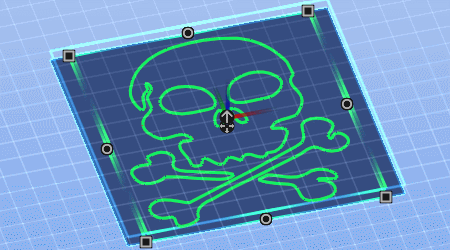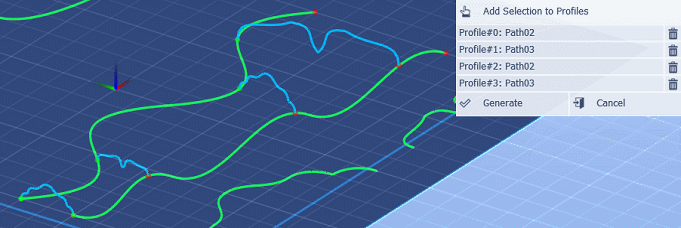Thanks for your interest in PixelCNC, these are some great questions!
I'd like to clear up any confusion: PixelCNC is unfortuantely *not* open-source software. I'm proud of the fact that I can offer the value that PixelCNC provides and considering how quickly it can pay for itself I think it's only fair that I be compensated for its use. More personally, I'm not currently earning an income with my programming skills elsewhere and the 2+ years working nearly full time on PixelCNC also cost my family their time. I owe it to them to generate an income of some kind from PixelCNC, so for the interim PixelCNC's source code will not be open to the public. Sorry!
My mission with PixelCNC is to provide the most valuable functionality and capabilities of software like Aspire/V-Carve/Carveco at price that's more affordable to smaller operations and DIY hobbyists/artists. This comes with other features that can't really be had elsewhere, such as unique original toolpath types and much better support for using images as input. PixelCNC is currently available as "early-access" alpha version software, it's a work-in-progress. Nonetheless, it's very capable when it comes to compositing project designs, generating toolpaths, and producing G-code. With the addition of the newer canvas-layer system users can now composite images, models, vectors, and TrueType/OpenType text together on their project's "canvas" which they can then generate a variety of CNC cut-paths off of. PixelCNC is capable of creating just about anything one would wish to create on a 3-axis CNC mill or router: relief carvings, V-carvings/B-carvings, stipples, half-tones, terrace-carvings, etc.
As for your question about a clipart libary, PixelCNC does not (currently) come with any clipart or model libraries. There are tentative plans to build a public asset/clipart library into PixelCNC's interface. This would allow users to seamlessly share images/models/vectors and browse what others have shared for use in their own projects. In the meantime, users are on their own creating and/or collecting assets to use in their projects. Fortunately, there are plenty of online sources for 3D models and also great TrueType/OpenType fonts which contain really nice elements to use as decorative pieces of a project. Users who know their way around graphic design software can also create grayscale designs as images to use in their projects, which is originally what PixelCNC was built for - model and vector support came later. This was because it was easier for my wife and I to work with creating designs in Photoshop for filling custom sign orders on Etsy than it was to deal with creating 3D models (which neither of us really know how to do).

PixelCNC is also capable of generating several different 3D shapes from 2D path vector input - which can either be hand-drawn, loaded from SVG files (soon DXF too), or generated from raster/model/text layers (or the canvas as a whole) using the trace-to-paths function. Path-sweeping capabilities have also been added in the most recent version, which are currently accessible via the path-edit mode. This allows using paths as 2D "profiles" which are extruded along another path "rail" - or spanning between two path rails. Path-sweeps blend between different profiles placed along the rails and are capable of creating a wide range of interesting shapes and decorative features. These are powerful features that have typically only been found in more expensive software and I'm proud to be able to provide them to PixelCNC users, and more generative functions for raster/path/text layers like these are on the way!


There are still plenty of things left to do to improve usability and educate users how to achieve different things, and just what the extent of the things possible with PixelCNC even are. Right now there's a dearth in any kind of learning resources - just the included User Guide (which is more of a reference) and an outdated tutorial or two. This leaves a lot of people confused about what exactly can be done with PixelCNC.
I made a conscious decision to focus almost exclusively on developing the best software that I possibly can, first-and-foremost, because it occurred to me that I'd otherwise be spreading myself too thin. I would be compromising PixelCNC's quality (and extending development time) if I were both developing and promoting it - which includes making tutorial/videos. This was especially the case because too much of PixelCNC's interface and features were still up in the air and I would end up having to update tutorials or re-do them entirely just so that they match with newer versions as things are moved around and changed. After PixelCNC is mostly complete and there are no more major changes to be made will I then transition into the "beta" phase of development, which means spending most of my time producing learning resources and promotional materials, such as tutorials, demonstration videos, and example project blog posts. In the meantime, I also cannot develop PixelCNC in a bubble - which is why it's available as early-access alpha version software, just so I can get *some* feedback about usability, bugs, feature requests, etc...
I would recommend that someone not comfortable using incomplete/unfinished software or figuring out how to use software on their own should wait a few more months until PixelCNC is at least in beta, when I'm actively providing learning resources and making demonstrations/tutorials/videos. The caveat is the higher price PixelCNC will have upon reaching beta status, due to incremental price increases that have accompanied (and will continue to accompany) the addition of new features and functionality. Existing paid-users receive additional features and functionality as they're rolled out at no extra charge. So, there *is* some incentive for users to get in early at the lower price (and hopefully provide feedback to help improve PixelCNC). Gaining more traffic and sales isn't yet the priority though, not until we reach beta and go into full PR mode.
At the end of the day, PixelCNC will likely never have all of the features or functionality of more expensive software, but it will certainly give them a run for their money and prove to be an extremely valuable tool for many. I suggest that at the very least everyone keep an eye out for when PixelCNC reaches beta this year ;)
Let me know if you have any other questions/comments/concerns and thanks again!
Charlie

